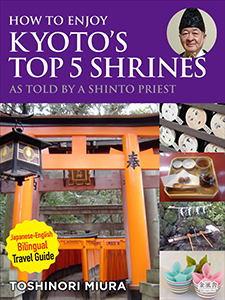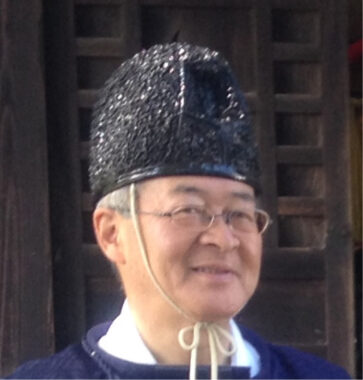- 歴史・地理
書籍名:神主さんが教えてくれる「京都の神社ベスト5」(日英バイリンガル版)
Outline書籍の概要
日本語+英語で知識を深めよう!神社をめぐる京都の旅
現職の神主さんが、京都の神社を旅して厳選したベスト5社を解説。
撮影から執筆まで全て神主さんオリジナルの神社めぐりガイドムックです。
【このような方に読んでもらいたい!】
・神社旅を日本語と英語の両方から楽しみたい人
○英題:How to Enjoy Kyoto’s Top 5 Shrines, as Told by a Shinto Priest(Japanese-English Bilingual Edition)
Visiting the shrines of Kyoto can be an enigmatic experience. While their physical beauty and long history command respect, it can be difficult to understand them in the context of a modern Japan that seems far removed from its Shinto roots.
Author Toshinori Miura is a Shinto priest and comes from a family of Shinto priests. As such, he has deep knowledge of Shinto shrines and a unique perspective on their place in modern Japanese society. He explains in detail the customs surrounding shrines and the proper way to enjoy them, as well as the reasons behind such customs. He also introduces various neighborhood foods and attractions that are popular with tourists and natives alike.
This book contains numerous photographs, taken by Mr. Miura himself, which help to illustrate and introduce each shrine. Specifically, Mr. Miura guides us through:
Fushimi Inari Shrine:This shrine is famous for the Senbon Torii, or “thousand gates.” Donated by local businesses in the belief that wishes “pass through” these gates, visitors ascend up a narrow stone path through countless gates with the knowledge that each gate represents the hopes and dreams of a benefactor.
Yasaka Shrine:Famous for the Gion Festival and particularly beloved by modern-day natives of Kyoto, Yasaka Shrine also has a fascinating history as the origin of a belief system in which vengeful spirits were placated through deification in shrines.
Kamo-Mioya Shrine (Shimogamo Shrine): In addition to being recognized by UNESCO as a World Cultural Heritage site and a Historic Monument of Ancient Kyoto, Kamo-Mioya Shrine is surrounded by a forest that has remained virtually unchanged for thousands of years.
Kifune Shrine:In ancient times, live horses were provided as offerings to the gods at shrines. Kifune Shrine is the first shrine at which horses were drawn onto wooden placards and offered to the gods rather than live horses.
Matsunō Shrine:Famous as the most important shrine for sake brewing, the reader can explore the relationship between sake and Shinto at this shrine.
Contents目次
はじめに
Introduction
著者プロフィール
Author Profile
本書の楽しみかた
How to Enjoy This Book
■神社にまつわる専門用語解説
■Vocabulary
■神主さんのとっておき神社ガイド
■Guide
神主さんが教えてくれる神社の参拝のしかた
The Proper Way to Visit Shinto Shrines
神主さんが教えてくれる「京都の神社ベスト5」
How to Enjoy Kyoto’s Top 5 Shrines, as Told by a Shinto Priest
一、伏見稲荷大社
“1万基におよぶ鳥居。それをくぐり抜けつつ、長く急な石段を上がるとイナリの神さま降臨の地”
1.Fushimi Inari Shrine
“Ten thousand torii (gates) extend into the distance. As you pass through the torii, you go up a long path of steep stone stairs until you reach the peaks where the deity Inari descended to Earth.”
二、八坂神社
“日本三大祭のひとつ祇園祭が行われる神社で、無病息災にご利益があります”
2.Yasaka Shrine
“At the shrine which hosts the Gion Festival, one of Japan’s top 3 festivals, one can receive a blessing for good health.”
三、賀茂御祖神社(下鴨神社)
“糺ノ森で縄文以来の霊気を感じながら歩む参道。参拝後に黒豆茶、黒豆とともにいただく塩が絶品”
3.Kamo-Mioya Shrine (Shimogamo Shrine)
“As you walk through Tadasu no Mori forest, you feel the aura of a place which has remained unchanged since the Jōmon Era. After visiting the shrine, you can enjoy delicious black soybeans with salt.”
◆コラム〈神主さんのパワー食〉申餅と黒豆茶
◆Column: Power Foods, from a Shinto Priest: Saru Mochi and Black Soybean Tea
四、貴布禰総本宮 貴船神社
“本殿の下にある龍穴は見れずとも、元の鎮座地である奥宮も参拝したい”
4.Kifune Main Sanctuary, Kifune Shrine
“While it is not possible to view the dragon well at the bottom of the main sanctuary, one may view the original place where deities were enshrined at the rear shrine.”
五、松尾大社
“社殿背後の松尾山頂上にある磐座。登れない場合は、滝明神で水神とともに山の霊気を感じたい”
5.Matsunō Shrine
“In the rear of the main shrine building, at the summit of Mount Matsunō is the dwelling place of a god. While it is difficult to climb to the summit, there you can enjoy the aura of the mountain along with a water god.”
特別セレクト
京都御所
Special Selection
Old Imperial Palace
“大きな池を中心とした回遊式庭園と共に、寝殿造り、書院造り、数寄屋風など日本の建築美を堪能したい”
“I hope that you have the opportunity to visit Kyoto Imperial Park and enjoy strolling around the central pond, enjoying the beauty of Heian Era palatial architecture, traditional tea houses, and other styles of buildings representative of various eras of Japanese architecture.”
◆コラム〈参拝と御朱印帳〉
◆Column: Shrines and Goshuinchō (Red Stamp Books)
あとがき
Afterword




